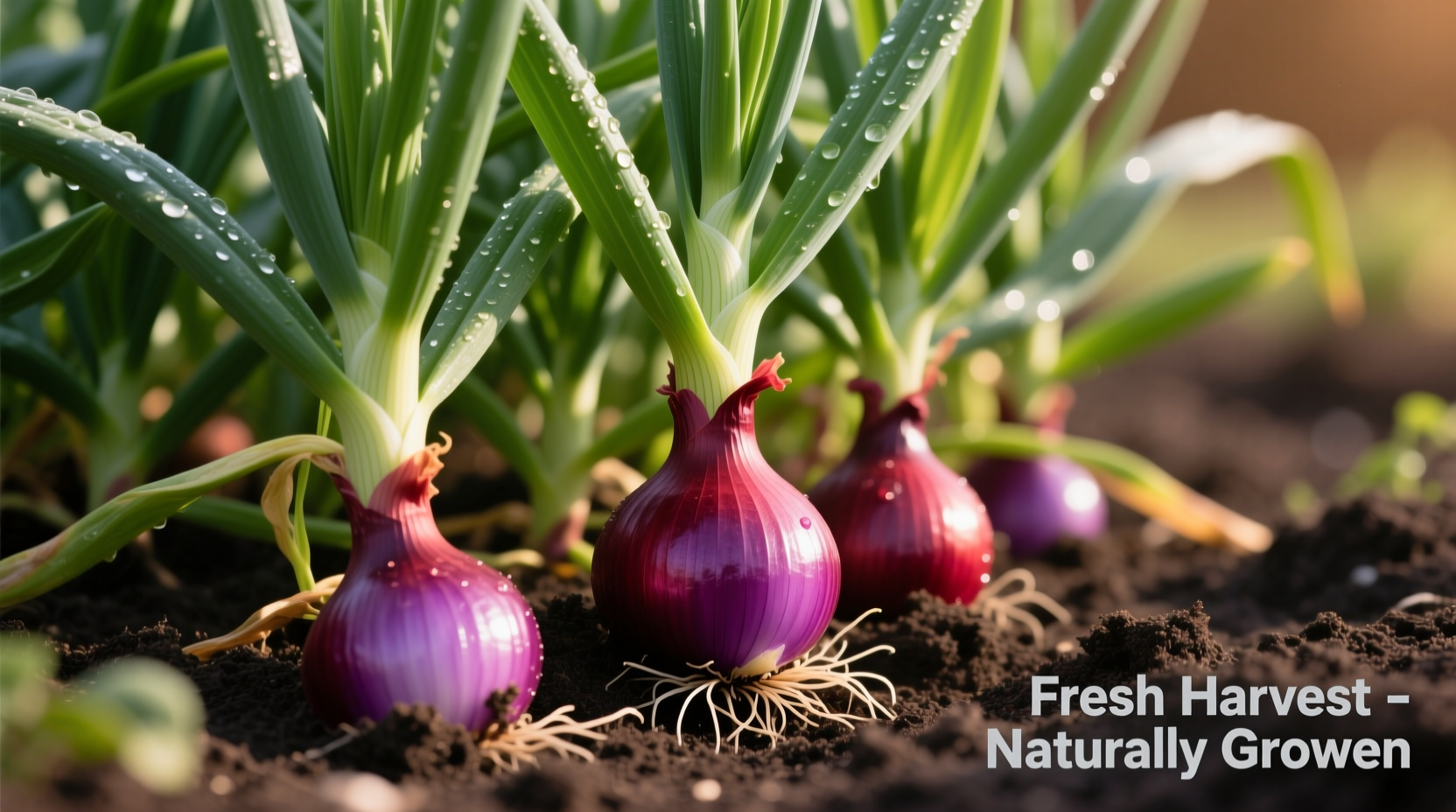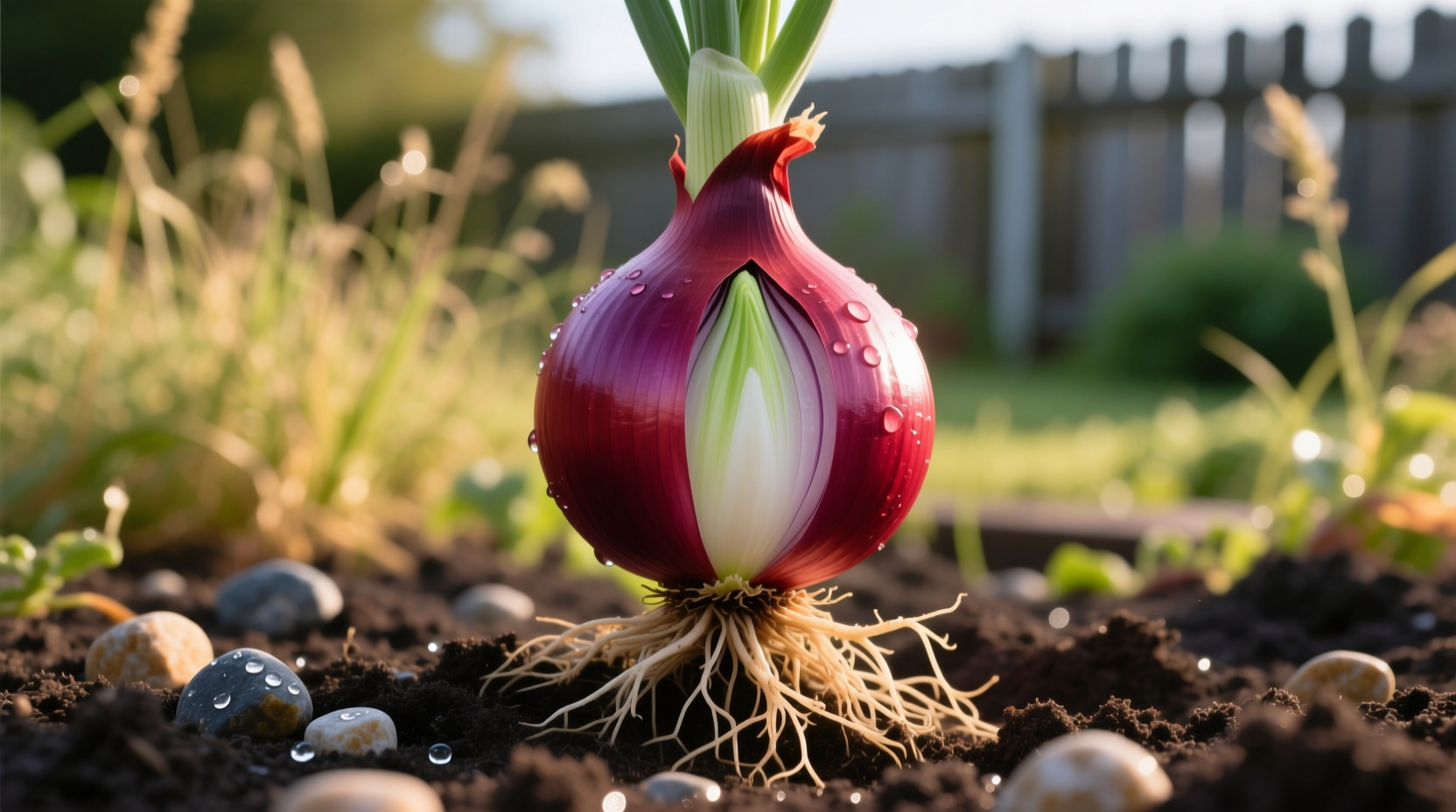Red onion plants (Allium cepa) produce vibrant purple bulbs with a milder, sweeter flavor than yellow onions. They require 90-110 days to mature, need full sun exposure, and thrive in well-draining soil with pH 6.0-6.8. Successful cultivation depends on proper planting depth (1 inch), spacing (4-6 inches apart), and consistent moisture during bulb formation.
Discover exactly what makes red onion plants different from other varieties and how to grow them successfully in your garden. Whether you're a first-time gardener or looking to perfect your allium cultivation, this guide delivers actionable techniques backed by horticultural science. You'll learn precise planting schedules, soil requirements, and harvesting methods that maximize both yield and flavor intensity.
Understanding Red Onion Plant Biology
Red onions belong to the Allium cepa species but express unique anthocyanin pigments that create their distinctive purple hue. Unlike yellow onions which develop stronger flavors during storage, red onions maintain a delicate balance of sweetness and sharpness ideal for fresh applications. The University of California Agriculture and Natural Resources confirms that red onion varieties like 'Red Wing' and 'Red Zeppelin' contain 10-15% more quercetin than yellow varieties, contributing to both their color and health benefits.
Optimal Planting Conditions for Red Onions
Timing your planting correctly determines your harvest success. In temperate climates, plant sets or seeds 4-6 weeks before your last expected frost date. Warmer regions should plant in fall for winter harvest. Cornell University's Vegetable Growing Guide recommends these specific conditions:
- Soil temperature: Minimum 50°F (10°C) at planting time
- Soil composition: Loamy soil with 2-3% organic matter
- pH level: 6.0-6.8 (slightly acidic to neutral)
- Sun exposure: Minimum 6-8 hours of direct sunlight daily
Prepare your garden bed by incorporating 2-3 inches of compost and a balanced fertilizer (10-10-10) two weeks before planting. Avoid fresh manure which can cause excessive leaf growth at the expense of bulb development.

Red Onion Growth Timeline: From Seed to Harvest
Understanding the developmental stages helps you provide appropriate care at critical moments. This timeline reflects data from USDA Agricultural Research Service field trials:
| Stage | Duration | Critical Care Requirements |
|---|---|---|
| Germination | 7-14 days | Keep soil consistently moist (not soggy) |
| Leaf Development | 30-45 days | Nitrogen-rich fertilizer every 2 weeks |
| Bulb Initiation | 10-14 days | Reduce watering, apply potassium-rich fertilizer |
| Bulb Maturation | 30-45 days | Gradually reduce watering as necks soften |
Red Onion Plant Care Requirements
Maintain consistent moisture during active growth, providing 1-1.5 inches of water weekly. During bulb formation (when tops begin to fall over), gradually reduce watering to prevent splitting. Mulch with straw or shredded leaves to maintain soil moisture and temperature while suppressing weeds.
Fertilize strategically: Use nitrogen-heavy fertilizer during leaf development, then switch to potassium-rich formula during bulb formation. Stop fertilizing completely three weeks before harvest. The USDA Plant Database notes that red onions require 25% less nitrogen than yellow varieties to prevent excessive top growth that delays bulb formation.
Red Onion Varieties Compared
Understanding the differences between onion types helps you select the right variety for your climate and culinary needs:
| Characteristic | Red Onions | Yellow Onions | White Onions |
|---|---|---|---|
| Flavor Profile | Mild, slightly sweet | Strong, pungent when raw | Sharp, crisp |
| Storage Life | 2-3 months | 4-6 months | 1-2 months |
| Best Use | Raw applications, salads | Cooking, caramelizing | Mexican cuisine, salsas |
| Days to Maturity | 90-110 | 100-120 | 90-100 |
Harvesting and Curing Red Onions
Harvest when approximately 50% of the tops have naturally fallen over and begun to yellow. Gently lift bulbs using a garden fork, taking care not to bruise them. Cure onions in a well-ventilated, shaded area for 2-3 weeks until necks are completely dry and papery. The National Onion Association recommends maintaining 75-80°F with 70-80% humidity during curing to maximize storage potential.
Store cured red onions in mesh bags or ventilated containers in a cool, dark place (55-60°F) with 65-70% humidity. Properly stored red onions maintain quality for 2-3 months, though they don't keep as long as yellow varieties due to their higher moisture content.
Troubleshooting Common Red Onion Problems
Address these frequent issues with targeted solutions:
- Thrips damage: Look for silvery streaks on leaves. Control with insecticidal soap or neem oil applications every 5-7 days.
- Pink root: Purple discoloration at root base. Prevent with crop rotation and soil solarization.
- Bulb splitting: Caused by irregular watering during bulb formation. Maintain consistent moisture levels.
- Double centers: Result from temperature fluctuations. Plant varieties bred for your specific climate zone.
The Cornell University Vegetable Disease Guide notes that red onions show greater resistance to downy mildew than yellow varieties but are more susceptible to neck rot during storage due to their thinner skin.
Frequently Asked Questions
Can I grow red onions in containers?
Yes, red onions grow well in containers at least 8 inches deep with drainage holes. Use a quality potting mix and maintain consistent moisture. Plant sets 1 inch deep and 3-4 inches apart. Container-grown onions require more frequent watering and weekly liquid fertilizer during active growth.
Why are my red onion bulbs small?
Small bulbs typically result from overcrowding, insufficient sunlight, or premature bulb formation. Ensure plants have 4-6 inches of spacing, receive 6-8 hours of direct sun daily, and avoid planting too early when cold temperatures trigger premature bulbing. Using sets instead of seeds can also improve bulb size consistency.
How do I prevent red onions from sprouting in storage?
Proper curing prevents sprouting. Cure onions for 2-3 weeks until necks are completely dry and papery. Store at 55-60°F with 65-70% humidity. Never store onions with potatoes, which release ethylene gas that promotes sprouting. Check stored onions monthly and remove any showing signs of decay.
Are red onion flowers edible?
Yes, red onion flowers (also called scapes) are completely edible with a mild onion flavor. Harvest when the flower head is still tight and before it opens. Use in salads, as garnish, or in stir-fries. Removing flower stalks directs energy back to bulb development if you're growing for mature bulbs.











 浙公网安备
33010002000092号
浙公网安备
33010002000092号 浙B2-20120091-4
浙B2-20120091-4